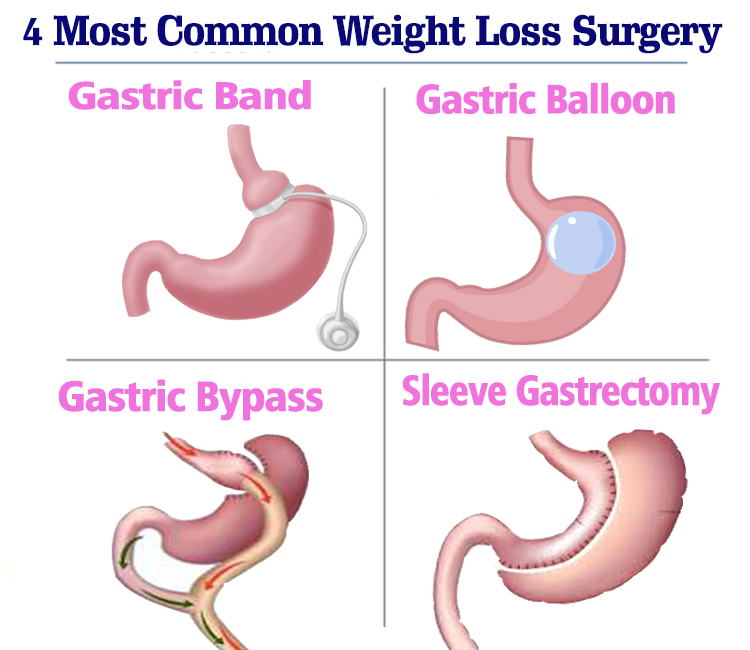Types of weight loss surgery
Weight loss surgery becomes the only option to get rid of excess weight when other non-surgical options like dietary and lifestyle modifications, exercises or workout do not help in reducing the excessive body weight.
Weight loss surgery is also known as Bariatric Surgery. Bariatric Surgery is a surgical procedure to lose weight by making changes to your digestive system such as:
- Making your stomach smaller, allowing you to eat and drink less at one time and making you feel full sooner
- Make changes in your small intestine—the part of the digestive tract that absorbs calories and nutrients from foods and beverages.
The most common weight loss surgery procedures, apart from biliopancreatic diversion with the duodenal switch are:
- Gastric Band
- Gastric Balloon
- Sleeve Gastrectomy
- Roux En Y Gastric Bypass Surgery
All these bariatric surgery procedures are performed if your body mass index (BMI) is 40 or higher.

Gastric Band
Gastric banding is a type of restrictive weight loss surgery in which a surgeon uses an inflatable band around the uppermost part of the stomach. When band is inflated it squeezes the stomach into two sections: a smaller upper pouch and a larger lower section.
The smaller upper pouch communicates with the rest of the stomach through a channel created by the band. The small upper pouch restricts the amount of food you can eat at one time. The band can be adjusted so that it restricts more or less food
Since band is adjustable and the procedure is performed with the help of a laparoscope, it is also referred to as Laparoscopic Adjustable Gastric Band surgery (LAGB).
Gastric Balloon
It is a non-surgical, safer and faster way to lose and control weight.Gastric Balloon or Intra-Gastric Balloon (IGB) procedure is for individuals who are 40% over-weight and at high-risk for anesthesia.
Gastric Balloon is a non-surgical procedure in which a saline-filled silicon balloon is inserted into the stomach with the help of an endoscope and kept in situ for a period of 6 to 12 months. Placement of gastric balloon is done using an endoscope having a thin, flexible tube that has a light and a camera on one end.
Gastric Balloon is maybe little uncomforting for some, usually painless and takes only 15-20 minutes. Balloon occupies most of the space in the stomach and leaves little space for food and hence gives a feeling of fullness quicker after smaller meals. You can lose about 20 to 30% of your excess weight following Gastric Ballooning.
Sleeve Gastrectomy
Sleeve Gastrectomy is a minimally invasive weight loss surgery performed with laparoscopy on young people who have attained or nearing their full adult height.
During Sleeve Gastrectomy Surgery, the stomach is reduced by removing around 75-85% of the stomach; leaving it like a tube or sleeve-shaped organ i.e. a new pouch that is more like a banana. Open edges surgically staple together to form a sleeve or tube.
Sleeve Gastrectomy is an irreversible procedure that reduces the size of your stomach capable of holding a small amount of food thereby reduce your appetite.
Roux en Y Gastric Bypass Surgery
Roux en Y gastric bypass is a weight loss surgery that combines both restrictive and malabsorptive approaches. In this surgery size of upper stomach is reduced to a small pouch by stapling upper part of stomach.
The pouch is connected directly to the middle portion of small intestine called jejunum. As a result, swallowed food coming to newly created pouch is passed into small intestine directly, bypassing stomach and upper part of small intestine i.e. duodenum.
The newly created pouch being small causes reduction in functional volume of stomach that not only reduces food intake but also curbs the amount of fat and calories absorbed from the foods.
Most of Roux en Y gastric bypass surgeries are performed under general anesthesia through laparoscope and may require multiple small incisions in the abdomen.
